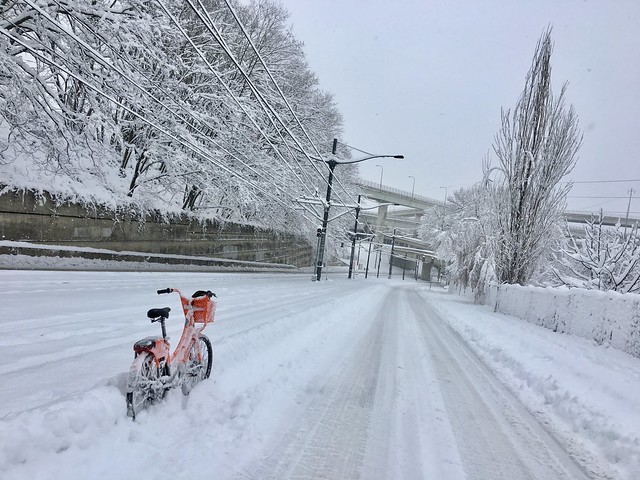
(Photos: J. Maus/BikePortland)
How does Biketown, Portland’s bike share system, stack up against other modes of travel during extreme weather? How would it work — or would it work at all — during a major snowstorm?
Those were the questions that have been on my mind after my brief foray on a Biketown bike late last night.
This morning I wanted to give it a real test. With twice as much snow on the ground as there was last night, I rolled over to my local Biketown station. My goal was to get downtown and back. Here’s what I learned…
Biketown is the most reliable public transit system we have
From a system perspective, Biketown is much more reliable than our buses, light rail, or streetcar. Throughout all this crazy snow and rain and ice we’ve had over the last few months, the system has remained online. There might have been a station here or there (out of 100) that was taken out of service due to ice or equipment damage; but there have been no systemwide shutdowns. And unlike those aforementioned modes of travel, since each Biketown user is also the operator of their transit vehicle there are never any delays in service.
When I walked up to rent a bike and saw about 10-inches of snow piled on top of the keypad display on the rear rack, I honestly didn’t expect it to work. Surely the freezing temps and all that ice and water would have gummed up the works right? I swiped away the snow, pushed the green button, waited a few seconds, and voilá! It woke right up. As I swiped my membership card I then figured the network might be down or slow; but a few seconds later I was entering my PIN number and the bike was ready to go.
Getting the bike unlocked and then locked again when I was done was very easy. This is another advantage of our dockless system. Other bike share systems require the entire front wheel to be rammed into a dock in order to finish a ride. Those often get jammed up with snow (thanks to Michael Andersen for pointing this out). The Biketown system uses a simple u-shaped locking bar that has to fit into two holes. Even with all this snow it worked without issue.
With snow piled high, the hardest part was wheeling the bike out of the parking spot and into the street.
The riding experience
Being able to check out a bike is one thing, but if the bike doesn’t work in extreme conditions the system would be useless.
I’m happy to report that the Biketown bikes worked very well. Not perfectly, but adequately. I did a nine-mile loop from N Interstate Avenue in the Overlook neighborhood down to SW Naito Parkway. I crossed the river via the Burnside Bridge (opting for the bridge with the least amount of elevation gain/loss) and used Martin Luther King Jr. Blvd, Grand Ave, North Williams and Killingsworth.
As I was warned by the Biketown folks, the 8-speed internal rear hub where the shifting happens tends to freeze up in cold weather. My shifter didn’t work at all. Luckily the bike I chose was in an easy gear so it worked fine for my entire trip. The bike itself was very sturdy. The hefty weight and upright riding position are not just great for seeing city sights and civilized commuting, they also do well in bad conditions. I notched my seat down a few numbers so that I’d have a lower center-of-gravity and so I could step off quickly if needed.
Advertisement
A note of caution: Because of their weight, slick and relatively narrow tires, you won’t go very far on streets with significant snow accumulation. I quickly realized that I would have to stay on major (plowed) routes if I wanted to get anywhere efficiently. Riding the main roads is much easier in snowy conditions, but of course they also have more motor vehicle traffic. Traffic was light today, but I was still constantly looking back over my shoulder to see if someone was coming. Sometimes I would pull over and nod to the approaching driver to pass me. Other times I would ride slowly and they would pass safely. And then of course some people drove past way too fast and close — but that also happens in normal weather conditions!
As for riding tips, there are a few things to keep in mind*. I would recommend lowering the tire pressure just a bit. The roads are very bumpy due to chunks of ice and snow being spit up by chained tires. Also don’t be too proud to put your feet out to gain balance. Coming down the big Interstate Ave hill toward Russell and coming down the Burnside Bridge into downtown I had both feet out and was using the bike sort of like a sit-down ski!
A few more equipment notes: The bell didn’t work too well because of some ice accumulation and the pedals sometimes slipped off my boots for the same reason. The front basket was a great place to stow my gear, but only after I scooped out all the snow to make some room.
*Please keep in mind that the assessment above comes from someone with a lot of riding experience (including racing) in all types of conditions. Your mileage may vary.
Plowing and potential
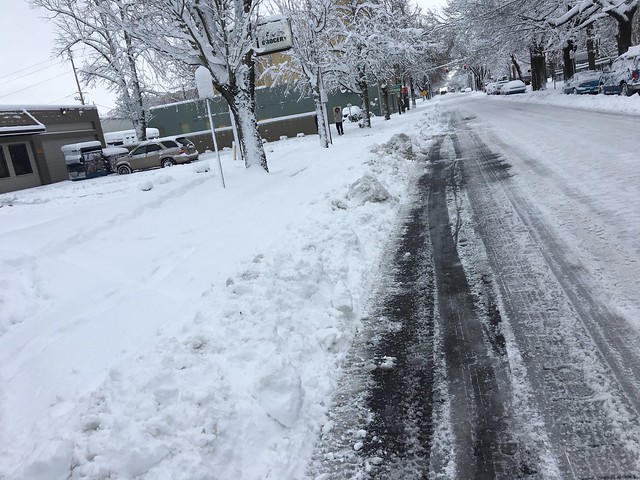
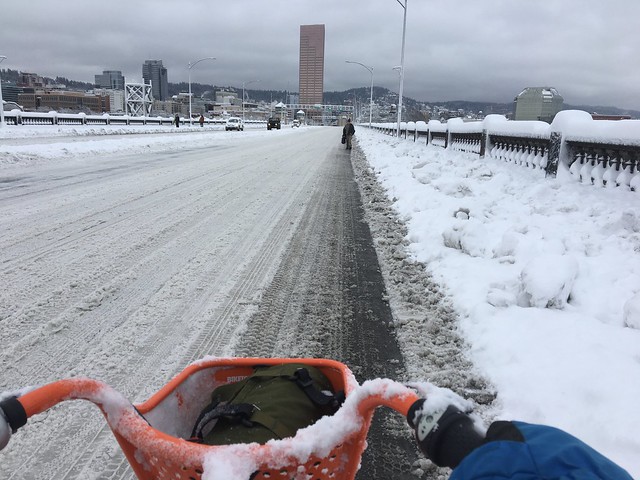
The problem isn’t that bikes are difficult to ride in these conditions, it’s that the conditions of our roads make it difficult to ride.
My biggest takeaway from my two hour ride was how much more potential Biketown has in conditions like this. I already feel like Biketown (and cycling in general) is a very resilient transportation mode; but it could be vastly improved. Unfortunately the City of Portland and other local road agencies don’t do anything to prioritize cycling routes during extreme weather events. None of the major cycling routes are plowed. Neither are major walkways.
While official messages tell people to stay home and not use cars, a lot of effort is made to ensure driving is still safe and convenient.
Is it unreasonable to ask that — in America’s best big city for biking — that at least some major bikeways get plowed? Even the bike lane on North Williams Avenue was still covered in snow today. I had to pedal the slight uphill and have people in cars whiz by just a few feet away from me.
If PBOT, Multnomah County and the Oregon Department of Transportation would commit to plowing a few key bikeways, Biketown would become a much more viable transit option.
The problem isn’t that bikes are difficult to ride in these conditions, it’s that the conditions of our roads make it difficult to ride.
According to Biketown folks, I was one of only 27 people to use the system today (so far). There’s no reason that number should be so low. The system works. The bikes work. This city is full of bike riders. If we had a bit more space to ride and some bike-specific plowing, Biketown would be a much more viable option for many more Portlanders.
And the winner is?
Not gonna’ lie. Using Biketown in these conditions wasn’t easy. In the end Biketown wins. Not by a knockout, but by points after 12 rounds (that’s a boxing reference). There’s a lot of snow out there and it took all my wits to make it home in one piece. The system itself is a champ. It has proven to be mighty strong and ready for anything. If our roads were maintained a bit more with cycling in mind, Biketown would have scored a knockout in the first round.
— Jonathan Maus: (503) 706-8804, @jonathan_maus on Twitter and jonathan@bikeportland.org
BikePortland is supported by the community (that means you!). Please become a subscriber or make a donation today.




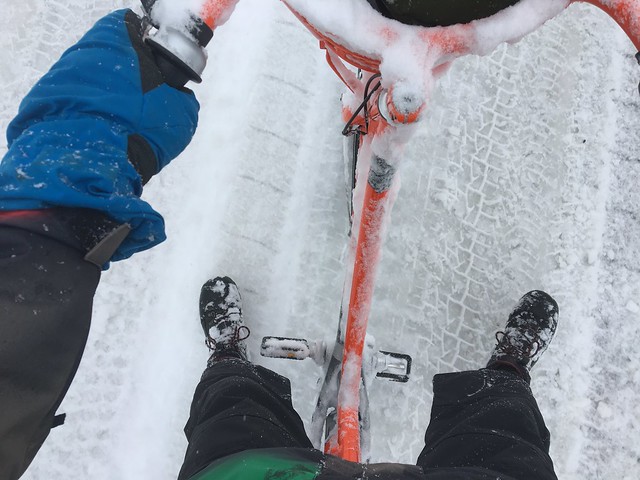
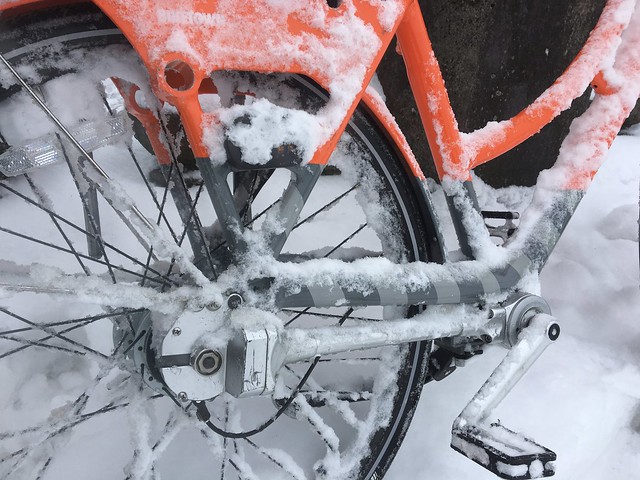
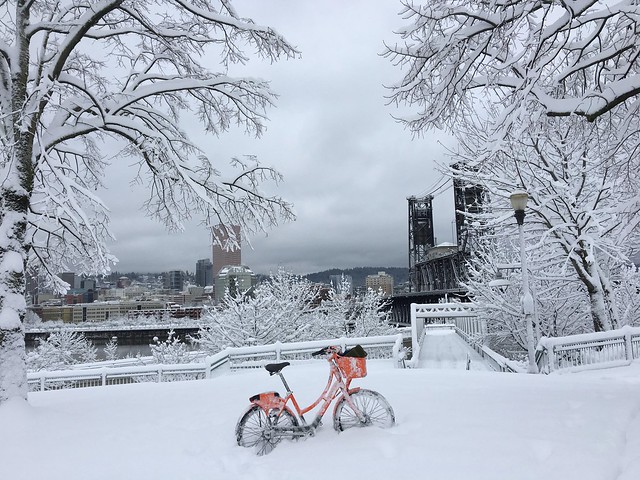



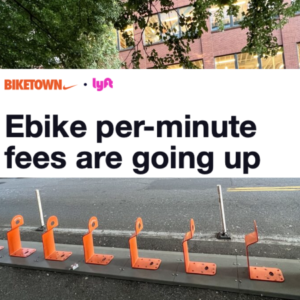
Thanks for reading.
BikePortland has served this community with independent community journalism since 2005. We rely on subscriptions from readers like you to survive. Your financial support is vital in keeping this valuable resource alive and well.
Please subscribe today to strengthen and expand our work.
Guessing the numbers are low today because most people who would ride in these conditions probably have their own bike. 😉
One of the 27 people who used the service here. I have my own bike but I wanted to test out Biketown in extreme conditions. This was just a 15-minute (mostly downhill) joyride, not a longer trip like Jonathan took. My experience was more or less exactly the same as his. I really had to mash on the keypad to get it to work at the beginning of the ride. The bike wouldn’t go through a foot of snow, especially not in the gear it was stuck in, so I rode on the traveled part of the streets. All pretty smooth sailing except for some chunky areas caused by chains. A little slipping and sliding but never lost control. It was great to see the full width of our streets being used freely by smiling people of all ages who weren’t in cars. Imagine….
I wonder how if the PBoT operations crews have “buried” any Biketown station pods in plowed snow yet? (Or have they been well directed to avoid such?) Anyone taking photos of this?
Living in a winter city, I am fortunate that our city council has adopted a winter cycling master plan. While still in its infancy, various key linkages (mostly MUPs, but some dedicated off-road cycle lanes) are being plowed by specialized equipment. In fact, these key cycling routes are usually plowed at the same time as the city’s major arterials. That said, most painted on-road bike lanes remain snowbound and unusable throughout most of the winter.
which city has a winter cycling master plan?
Likely:
https://www.minnpost.com/cityscape/2016/12/minneapolis-breaking-new-ground-winter-plowing-protected-bike-lanes
Though, honestly, most wintry major cities have some sort of plow plan.
Chicago has a plan: dumping all snow into the bike lanes. 😛
I “commuted” to downtown Minneapolis yesterday, after 3 straight days of morning snowstorms (only 5″ total, so less than Portland just got, FWIW).
It’s true that “Standard” 5-6 foot unprotected bike lanes often don’t get plowed for a while, and can be unusable for much of the winter. This is one of the reasons Minneapolis doesn’t have a ton of them.
I ride the Park/Portland couplet (my most direct route) downtown in the morning , and its 20’+ wide (including buffers) bike lanes on the Portland/Park couplet weren’t plowed yet, and were pretty dicey in places. They should be clear now, though, since the city declared a snow emergency yesterday afternoon. Despite the dire label, this nothing like Oregon’s current state of emergency and is just a bureaucratic term for the 3-day process of clearing EVERY street in the city, including side streets, which takes 3 days.
We have miles of new protected bike lanes, and from what I can see they are getting plowed right away, as noted in the above MinnPost story. I rode the spanking-new 3rd Ave protected lane and it was mostly in great shape, except the one block next to city hall where it was posted “bike lane closed” and several city vehicles were parked in it. Durrrrr. I also passed by the 26th/28th St protected lanes and noted that they had been cleared too.
And as usual, our 100+-mile network of off-street pathways had already been cleared. They always are, often before the major streets. MUPs have their downsides, but in a climate where it snows often and the snow sticks around, it makes sense to have fully separate paths. Most of them run right next to significant streets, and I chose a route home last night on these paths – a bit longer than ripping right down Portland Avenue, but much less stress. Again, hopefully by now Portland Ave should be in good shape.
I cannot stress how important it is that IF you are going to have on-street protected lanes (or any path immediately adjacent to the street), you have GOT to have a plowing plan in place. Because the plows that clear the adjacent street are going to cover it in debris. And that chunky plow debris is far, far harder to ride in than naturally fallen snow. My skinny-tire bike can handle 4-5″ of fresh snow, but an inch of plow debris sends me fishtailing all over. Even my fatbike becomes unrideable in more than 2-3″ of it.
Great piece, Jonathan. I thoroughly enjoyed it.
and I know you don’t like the term, but your mentioning this:
“While official messages tell people to stay home and not use cars, a lot of effort is made to ensure driving is still safe and convenient. ”
brings to mind Alan Durning’s term – Carhead.
P.S. PIN = Personal Identification Number
PIN number = Personal Identification Number Number
Or maybe it’s because the streets need to be open for emergency trips, emergency vehicles, and truck deliveries.
No no no, that’s too rational.
Right. That one.
The familiar stick with which to beat your opponent over most any issue. The effort to allow Skinny Streets in Portland, which dates to the early nineties, ran into this one too. Lots of pushback, until some smart person invited the fire dept. to drive their trucks on a section of an existing street that was much narrower than the code specified at the time, but equivalent to what the Skinny Streets folk were wanting to permit, and guess what?! They fit.
So tired of the mischief perpetuated in the name of emergency vehicle access.
Road furniture doesn’t make it easy to plow bike lanes. Even on Williams, you’d they’d be blocked by snowbanks around the median. Just sayin’.
If Williams was built with a protected bike lane rather than a shared lane with concrete diverters, it could have been easily plowed by PBOT’s bike lane sized snow plow. Just sayin’. 😉
No such.
a bike lane sweeper is not a bike lane plow.
Does this mythical creature (Portland’s rumored bike lane sweeper) actually exist?
ATV with a front plow attachment. My Missoulian relatives know they’re all the rage.
One gear is enough.
That depends which gear you’re stuck in. Gear 7 or 8 isn’t appropriate for climbing an icy hill/bridge.
What would really tell us that PBOT prioritized active transit is if they would clear the bike lanes of all the gravel put down for the benefit of motor vehicle traffic. It usually seems to take about three weeks for all of the bike lanes to be swept, even while the main traffic lanes are perfectly clean.
The gravel is more than a nuisance, it’s a severe hazard to two-wheeled vehicles.
Agreed. PBOT needs to stop laying gravel down if it takes them three weeks to clean it up. It always ends up in the bike lanes. The Stark green lane downtown was absurdly covered in gravel yesterday before the snowstorm hit.
Gravel is not a danger, nor a nuisance. These comments are misleading. Furthermore, the tone of the article around providing optimal surface care in these conditions is silly as well. I’m glad Johnathan created this experiment of the bike share system in adverse conditions, but to dream of pristine pampered pavement in 12″ of snow is nuts. I’ve biked in winter for 35 years. It’s a blast. It changes minute by minute, foot by foot, street by street. Enjoy it! Ride yur friggin bike.
I have a friend who sustained injuries when he slipped on gravel riding his Vespa. So don’t tell me the gravel poses no danger.
Snow is one thing, but laying down gravel is a conscious choice made by PBOT. It is certainly reasonable to request this practice be halted if timely cleanup is not an option.
Tell that to my partner who slammed into the side of a van that pulled out in front of her last week. She started to slide sideways and couldn’t stop in time to avoid a painful impact.
Riding on gravel is no problem until you need to turn or stop. Kind of like ice.
I stand by my statement that gravelly bike lanes are a hazard.
Gravel is part of the environment. Whereever you are and whatever you’re on, being safe absolutely requires adjusting what’s out there. Riding like you’re on dry pavement when you’re on anything but *will* is failing to adjust for conditions and *will* cause problems.
The snow is part of the environment. Gravel is not. Gravel is put down purposefully to aid motor vehicle travel.
I assure you it is very helpful for everyone including bikes well when there is ice. Marquam Hill is unclimbable and dangerous to descend without it unless you have studs. I don’t particularly enjoy the stuff, but since things don’t get cleared here and they don’t use salt, you really don’t want solid ice.
I rode this morning, and the graveled streets were by far the best. If only they’d sweep it up once the snow is gone…
Salt application, the other big way to reduce the slickness of snowy and icy streets, presents a worse problem: it rusts steel dramatically.
Gravel is annoying and hazardous to bike tires, but once the worst of the weather is over, the DOT around here starts to sweep it back up for re-use.
3 weeks is generous. They will also fail to get clean up on all of the material they put down. Several years ago, I kept calling them for months about a couple of bike lane sections that they missed and never picked up all the gravel from the previous winter storm event, and they finally told me that their cleanup program was finished and they were no longer picking up winter storm gravel. They will always take too long to pick it up, and never get it all cleaned up. Not sure how they can cover the city with gravel in one day but take months to pick it up.
After the snow melts, I am going to sweep the bike lanes on my block myself. I am growing weary of constantly pestering PBOT to do their jobs.
“What would really tell us that PBOT prioritized active transit is if they would clear the bike lanes of all the gravel put down for the benefit of motor vehicle traffic. …” mark
Do you feel PBOT could get the gravel all swept out of the bike lanes in a timely, cost effective manner, considering the cycle of snowy and icy weather we’ve had since the first of the year? Seems like we’ve had two or three storms in close succession to each other. The first gravel got laid down, and shortly after the ice melted away, another storm came, and more gravel.
Before this last storm hit, I saw gravel cleanup on some of the roads. Now we got more of the gravel. Neither PBOT or ODOT is going to be able to keep up with cleanup, until the winter storms cease. Pooh. gravel is still way better than salt. Many people seem to feel unable to do it, but after these gravel blitzkriegs, I ride on the parts of the main lanes of the road from which motor vehicle tires have blasted the pavement clear of gravel. Probably a good thing too, for people riding scooters and motorcyles to do.
My guess is that the type of people who ride in this stuff feel pretty confident of their abilities so unusable lanes don’t cause that much trouble.
When the roads are really bad, I think it might actually be safer for cyclists because there are fewer drivers, they go slower, and they tend to drive better since natural selection is pretty brutal on people who use bad judgment on ice.
I strongly disagree on both counts, based on experience. My wife and son are anything but confident and competent on bikes. However, they are committed to not driving intra-city, so when the snow lands they walk and ride. Both of them have been extremely displeased to find that their only choice when it snows is trying to share the lane on arterials. They are mostly walking because of that, but the sidewalks aren’t exactly functional either.
When road conditions are bad, you would hope that motorists would compensate by slowing down. However, go look at the crash log and, at least where I live at the south end of the Willamette Valley, crashes are way up in spite of reduced traffic counts. Nope, we’re not feeling safer sharing the road with people who are driving on the edge when friction is compromised.
I get that. But in conditions like we have now, ice is a much bigger issue than cars. Even if there were zero cars, this is not a good time for anyone who doesn’t have really solid skills to be on a bike — including in the very few areas where the roads have been cleared. Ice causes violent crashes on bikes.
Yes, cars are sliding all over the place and I’ve seen plenty of it myself, but I haven’t personally had anything that’s even vaguely close to a hairy encounter. Visibility is awesome, people are holding speeds way day and cutting lots of extra space, it’s easy to tell what’s going on, and I’m finding that it takes much less vigilance than normal to get around. Yesterday, I went down the middle of Lombard for a few miles. Easy peasy. That’s not fun on most days.
I think it’s silly to ride in these conditions, especially if you have a reliable vehicle with chains. I saw a couple riding yesterday. No helmets, fenders, or lights. I asked myself why, unless you have no other option. It’s great to be hardcore until you smack your head. I walked almost 15 miles yesterday, no problem.
As for the why, it’s for the same reason as anything else — people like it. It’s fun and safe enough if you know what you’re doing.
I have AWD, traction tires, chains, and my car is dug out. I enjoy driving in challenging conditions (just last Sunday, I drove many miles on unplowed roads in the Cascades where I was dragging the bottom of the car in the snow). But in town is just slow boring driving with an elevated risk of getting hit by improperly equipped motorists who don’t know what they’re doing. And skiing 15 miles RT to work is going to be more fun anyway.
Out in Central Beaverton yesterday, the snow was so deep and fluffy on the streets near where I live, it made biking virtually impossible. Midday today, with snow packed down and slushy in places, riding was easier than walking. Less hassle than driving…the pickup with four wheel drive got to stay home, and barney the purple mountain bike got to go out and show what it can do in snow: not bad at all.
Curious how many people at the Nike campus used the company’s bike share bikes. Same model as Downtown is using.
Kind of glossed over this, but this test would have been a total failure if the bike had been left in a big gear.
So cool !
I wasn’t able to use a biketown bike because I couldn’t get one to accept my account number. I assume it was because of the icy keypads. It either didn’t read the number I was attempting to type in or read it multiple times and would send me back to the beginning.
I like the convenience of leaving my bike in the garage at the Orange line Park Ave stop and then picking up Biketown in the city but I haven’t had good luck if it is under 40 and raining. Cold without rain is okay but both together either mess up the bike computer or my fingers (or both).
The gears aren’t likely seizing up in the cold, they are sealed and should have proper oil based lubrication (would need to be much colder to freeze). Most likely the problem is that the wire running from the shifter to the hub is freezing in the cable. Or that the grip shifter is freezing over.
My old school IGH three speeds work fine in the snow (other than caliper brakes and steel rims who needs to stop anyway) but the difference is that wires aren’t contained in any kind of housing and that I use thumb shifters.
When I was in college at University of Illinois I rode an old two-speed hub-geared “coaster-shifting” (pedal back lightly to shift) Schwinn — no shift or brake cables, everything in the rear hub! There seemed to be a temperature below which it wouldn’t shift, but it was way below freezing. The brakes did work, fortunately.
Al, when were you there?
That’s my undergrad Alma Mater…we used to get some wicked ice storms.
Unless they’re using incredibly cheap cable housings and wire, that shouldn’t be an issue. While that is a possibility, this just isn’t going to happen with good cables in teflon coated housings. If cables were an issue, brakes should also be affected.
Jonathan would be able to tell since he was there to experience exactly how they don’t work, but I’d be inclined to suspect heavier grease used to increase durability getting thick.
Looks like you guys need to groom!
https://www.facebook.com/cuyunalakesmtb/posts/1228966890512426
Here is some advice from the Vancouver, BC experience. If they ever do start plowing the bike routes in Portland, they should intentionally plow the bike routes only after the major general arterials have been done and have proof of that somewhere otherwise the mainstream media will complain that bikes are getting special treatment while “normal people” are suffering.
It seems like skinny tires do better on the medium-soft stuff than wider slicks. I tried 28s and 50s today — two different bikes but similar geometry. The slushy ruts and holes in the packed snow are the worst part of it and the bigger tires seemed to float/slide around rather than sink in. The narrower tires are better on loose snow too, but beyond 6in deep, you keep getting your pedals in it.
“I rolled over to my local Biketown station.”
That must be nice. Closest one to me is 4 miles away, and I don’t even live east of 82nd.
SNOW PLOW ON WILLAMETTE! Between Rosa Parks & Greeley. Probably a good thing for restoring this popular bike route normally closed to through traffic, but the 10 to 20 of us on X-C skis were not too pleased to have the road exposed where vehicle traffic had previously packed the snow down nicely. At the time, it seemed the driver of the plow was simply trying to restore his favorite cut through between Rosa Parks and Greeley. It is clear to me that many car drivers evade the detour down Rosa Parks to Greeley. It is nearly impossible to take a left onto Greeley heading west on Killingsworth due to the line up of cars coming from Willamette who have the right of way to turn right onto Greeley around 7:30 on weekday mornings.
This may have been the case yesterday, but today the roads are busier and icier, having been driven on all day yesterday. MAX is back on its regular schedule, but busses are still chained. Skis were the best non-motorized way to get around yesterday, anyway.
At least on level pavement that had the snow already compacted by car traffic, I found my old MTB was a better way to get around than XC skis when I went for a joyride yesterday. I was going about twice as fast as the people on skis, and I wasn’t even trying to go fast.
My ATV was the best ride in town the last two days.
FWIW, Car2Go has suspended service until the roads get cleared up
The city not clearing bike lanes/major sidewalks during storms is just where the problem starts. I don’t really expect less used bike lanes to be cleared of gravel but nothing was done for weeks to clear gravel off some of the most frequently used bike lanes in the city.
Walked to work this morning and still no attempt had been made to clear the sidewalk on the Burnside Bridge. On my ride home yesterday, the Morrison Bridge separated sidewalk was well cleared, so I’m not sure why they didn’t touch the Burnside.
The county likely cleared the Morrison so that the bridge operator could continue to park on the bike path.
It is wide enough to fit a plow. We don’t have any sidewalk plows.
Most businesses that I passed had cleared their sidewalks, and I know they didn’t use plows for that. The city brought extra road equipment down from Seattle to deal with the snow and surely had extra staffing too. All that effort, and they can’t be bothered to send a few workers out with shovels and salt for the sidewalks? It becomes even more dangerous as the traffic lanes are clear enough for drivers to feel like they can resume normal driving speeds, ~10 over the posted limit. I don’t feel comfortable walking in the road with cars buzzing by on still treacherous pavement.
Snow events like this make it utterly clear that cars are still at the top of the transportation hierarchy and everyone else is just an afterthought.
Other stuff needs to be set up to do better. I have 8 miles to go to work this morning, and MAX is not running at all (again) and buses are messed up (again).
I’ll ski in today, but most people don’t have that option. The funny thing is that even if conditions were perfect and transit ran the way it’s supposed to, I could jog in less time than it takes for transit.
That’s why people drive — the alternatives need to be much better. I asked a coworker why she drives when traffic is so slow I can get by it on foot. She acknowledged on foot would be faster but didn’t want to be out in conditions and added, “at least I’m in my own environment.”
I texted a picture of the deep snow on the Burnside Bridge sidewalk this morning to a contact who works with Multnomah County. He said they’ve actually cleared it more than once, but when the city comes by to plow the motor traffic lanes, they push the snow all up on the sidewalk.
Thanks PBOT for prioritizing motor vehicle traffic (again) at the expense of all other modes!
I saw a small ATV/UTV based plow plowing the sidewalk of the Hawthorne Bridge. Right in front of a rather dejected cross country skier.
The Hawthorne bridge was pretty nice. The east side esplanade was not.
http://imgur.com/a/CxKYc.
Jonathan, another fun and great story. I was surprised (and encouraged) to see you lay a knock on the PBOT maintenance efforts. Not sure I have ever seen you directly do that, before. I know maintenance is boring and not nearly as sexy a topic as infrastructure design, but it tends to affect us all on a regular basis. We need to advocate for our 7% (mode) share of the maintenance budget, also! Keep it up.
Who is responsible for repairs or replacements when thes bikes get trashed in any way when rented under these conditions?
Ottawa actually. Canada has several cities, including Montreal and Toronto that are making a real effort to ensure bike commuting is at least somewhat feasible 365 days a year.
Ooops – I had intended to reply to Cyclekrieg
Great writeup.
I was also one of the 27 who rode biketown, took two trips actually. I had trouble shifting gears and holding my line but I had a lot fun anyway, because cycling is pure bliss when 99% of motor vehicles are parked and/or abandoned.
” I rolled over to my local Biketown station.”
Must be nice. Closest station to my house is about 4 miles and I don’t even live east of 82nd.
I’m thinking of taking one of these out today, but guessing that all my usual discomforts with them are going to be worse. Lowering the seat more than usual will leave me reaching even higher for the handlebar, and riding with my hands higher than my shoulders is already awkward.
Road salt kills bike internals.